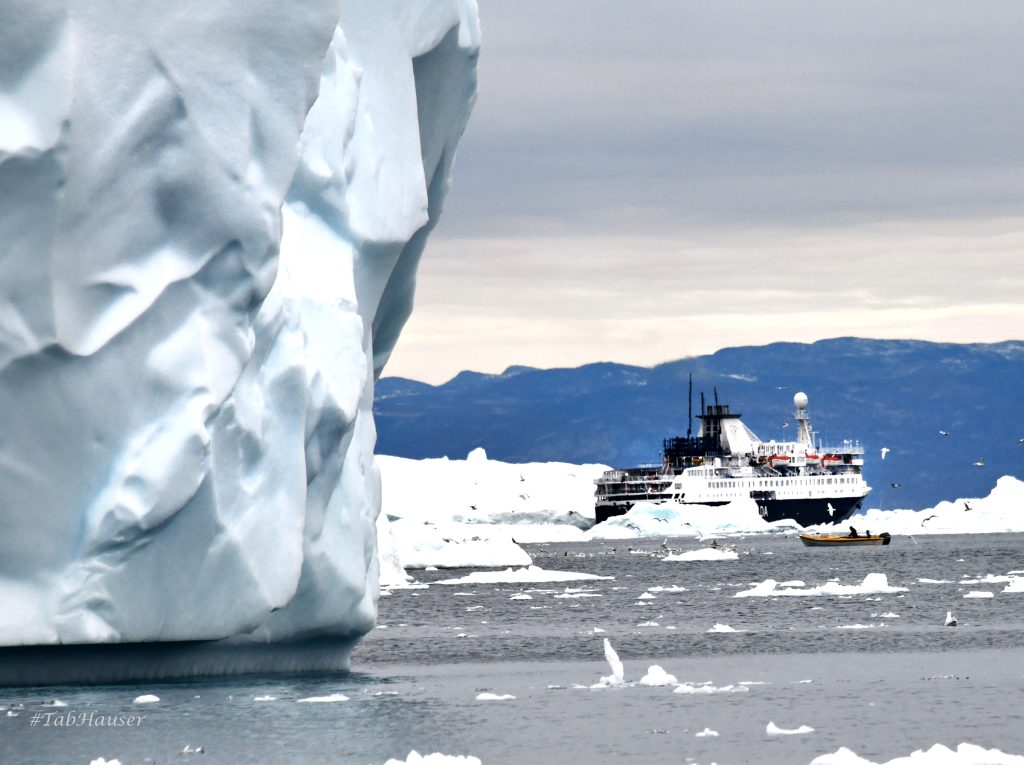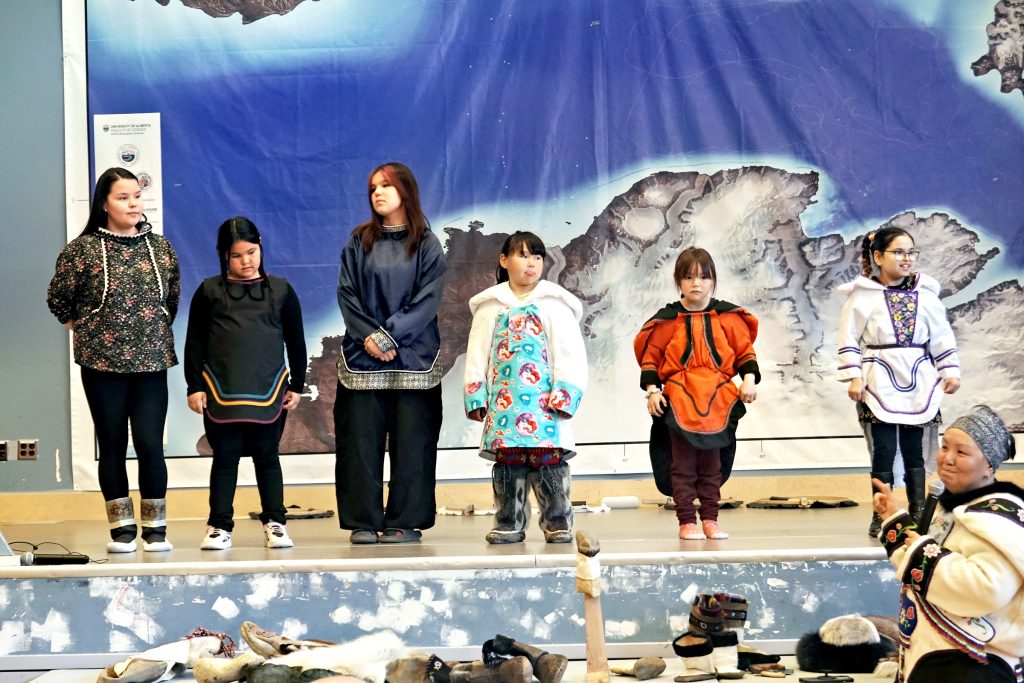Cruising the Northwest Passage in the high Arctic is something casual boaters cannot do on their own. For my Arctic experience, I went with the experts at Adventure Canada. For 17 days we explored 3255 miles of remote waterways in the high latitudes of the world.
The Northwest Passage connects the Atlantic and Pacific Oceans in the Arctic Sea via northern Canada. Our cruise weaved its way through beautiful scenery, including barren rocky and snowy mountainous islands, narrow channels, fjords, fog, and icebergs.
Since the early days of European trading with the Far East, the idea of finding a shortcut over Canada was a quest. A northwest passage could take trading ships 8,000 miles direct, versus 14,600 miles sailing around South America.
Much is written about the early explorers seeking fame and fortune who tried and died making the earliest attempts to cross. The most famous of these was Sir John Franklin and his 129 men who left England in 1845 with two ships. They all froze or starved to death two years after their boats were crushed by ice and had to abandon ship to the barren islands. Our ship visited the graves of three sailors who died earlier in that expedition. Lectures and songs aboard the Ocean Endeavor were dedicated to Franklin and his crew.

Daily Routine
Expedition cruising is different from the large ships that call on the Caribbean Islands. Those ships can carry 3,000 to 7,600 passengers. The Ocean Endeavor tops out at 198 like-minded passengers who did not come aboard to see staged shows, visit a casino, and dress up. The goal of most expedition passengers is to explore where only a small ship can take you.
Passengers cruising with Adventure Canada did not sign up to sleep late. If we had a morning landing, a cheery wake-up announcement came on the speaker between 7am and 8am giving our position, weather, and any schedule update. Following breakfast, you would go to the mud room to don your life jacket and rubber boots (provided) before boarding a Zodiac.
At the landing beach, guests would leave their life jackets and switch over to hiking shoes to explore the area. The landings were made in the most scenic places that also had historical or geological significance. There were also cultural visits to remote communities and cities.
Depending on the landing site, guests were either guided around or hiked about on their own. There were always expedition leaders stationed around to answer questions based on their expertise. At the landings, polar bear guards would be stationed on perimeters to keep watch or walk ahead of a guided hike.
For the evenings, the routine aboard would have all the guests come to the Nautilus lounge before supper (as it is called aboard), for the daily briefing. This was a good time to order a cocktail or beer of the day. The briefing would include time to reflect on the day as well as hear expedition experts talk about what we saw at the day’s landing. This was followed by information on the next day’s stop. It would include weather, wind, and ice flow maps. Landings can and do change pending weather and polar bear activity.
While at sea, the bridge is always open to visit. Detailed tours are also offered for those who want to know more about the ship’s navigation and systems.
Ocean Endeavor Stops
During our 17-day cruise, the ship stopped in over a dozen places. Each location was scenic and unique. The landings had us walk on crushed rock and soft tundra. During these stops, from a distance, we spotted polar bears, seals, an arctic fox, a herd of musk ox and walrus as well as many birds. There were bays where guests went on scenic zodiac rides.
It was at these landings that our expedition leader encouraged us to find a quiet place to reflect on our whereabouts. This was not only calming but also got us to appreciate absolute silence. During a Zodiac cruise, our driver turned off the motor so we could hear nothing but the water running off a glacier waterfall from a thousand feet up. Below are a few highlighted stops.
In Port Epworth, we hiked up to a bluff that had 1.9 billion-year-old stromatolite fossils. Stromatolites were the earliest bacterial organisms that gave life to our planet by producing oxygen. Port Epworth is under consideration as a UNESCO World Heritage site due to its natural beauty and geological significance in Earth’s evolution.
Bellot Strait is a 16-mile-long scenic narrow strait where the Atlantic and Pacific Ocean tides meet. Jutting north near the middle of the strait is the most northern place on the North American continent. Here our expedition leader read a poem and led a toast for being on top of the continent with Sailor’s brand rum for all. It is here we spotted the bright white beluga whales along the cliff in the distance.
Beechey Island is 1.8 square miles and has three of Franklin’s crewmembers who died during their first winter buried here. Two other graves include someone from a later search party and another illegally placed there that is said to be a Franklin expedition buff. There are plaques and cairns dedicated to other explorers and ships that visited here. You also see the remains of a storehouse used by search parties looking for Franklin. During our walk, our geologist picked up perfect pieces of fossilized coral from a sea here 450 million years ago.
Devon Island is the largest uninhabited island on Earth. The ride through the fjord at our landing was beautiful. At Powell Inlet, we admired the 3000-foot walls that went up to the island’s large ice cap. The reflections on the water off the cliff along with a few small blue icebergs made perfect photos. From the beach, we viewed a herd of walrus in the cove opposite our landing.
78 Degrees North
When the Endeavor could not call on Qaanaaq, Greenland due to wind it headed north with the goal of 78 degrees. On the way, we noticed the ice building up. At our peak latitude of 78 degrees or 720 miles from the North Pole, passengers put on their warmest clothes to meet on the aft deck. Here our cruise director read a page from the Norwegian explorer Fridtjof Nansen written in 1893 and led a toast to being here.

Icebergs Up Close
During the passage, we cruised by many icebergs. A highlight was getting up close and personal in small boats twice on Greenland’s west coast which has some of the most active glaciers. The icebergs ranged from the size of our ship to that of a small town. Their colors ranged from white to lightblue with some having a height of over 200 feet. One 1500-foot iceberg with an arch looked like a floating fort. Guests loved the floating “polar bar” with polar bear-dressed staff passing out hot chocolate spiked with Bailey’s from a zodiac.
Communities
Our port of call took us to communities in Canada and Greenland. During our visits, we were welcomed with regional music by schoolchildren, saw the style and warmth of Inuit clothes made from regional animals, took a tour through the towns, and visited their cultural centers. One village treated us to musk ox sliders, smoked narwhale, arctic char, and a local berry cake. We learned here that people live off the land and sea for their protein and clothes.
Inuit Experience
The understanding of Inuit culture is an important part of Adventure Canada. On board were several Inuit team members and special guests. Each shared something about the way they lived presently or from the past. This included movies, art, personal stories as well as a discussion on the terrible mandatory resettlement of families by the Canadian government back in the 1950’s.
Guests were also treated to an Inuit “Taste of the Place” twice. This included whale, seal, caribou, reindeer, and arctic char. They were served raw and frozen with a little soy sauce as well as dried. We learned why it was served that way and how rich in protein Inuit’s diets are.

A highlight was having Aleqa Hammond aboard. She was Greenland’s first woman prime minister in 2013. Each evening, she would teach us an Inuit phrase. She gave lectures on Greenland politics as well as her own story of living seven weeks on the ice. Aleqa led workshops on Inuit beading.
Sea Time
When at sea there were always activities going on. This included lectures about history, glaciers, geology, botany, birds, local wildlife, regional handcrafts, beer tasting as well as music. During the cruise, passengers had an opportunity to take the polar plunge. I recommend trying this once. It will wake every sense in your body. Most plungers lasted about 15 seconds before climbing up the ladder.
Evening entertainment included music by an award-winning guitarist, interactive games with the expedition team, one fish-themed disco dance in Disko Bay, and a few documentaries.
Northern Lights
Viewing the aurora borealis is a highlight of any arctic trip. When the lights were showing well, an announcement was made. This got everyone moving quickly to dress and get to the stern where the lights were turned off for better viewing. We witnessed mostly shades of green with a tinge of red swirling across the sky.
The Ocean Endeavor
The Ocean Endeavor is 450 feet long, 69 feet at beam with a draft of 19 feet having an ice-strengthen hull. The Endeavor is ideal for getting into small bays, narrow channels, and fjords. She holds 198 passengers and a crew of 124. The ship is roomy with its nine decks and four lounges. I was more comfortable aboard the Endeavor than I was on a 1040-foot cruise ship with 3100 passengers I boarded earlier this year to Bermuda.
The ship has several different class cabins to meet different budgets. I opted for a wide cabin on deck seven that we found comfortable. The best part of this ship is that you can be anywhere on it within two minutes of your cabin.
Chef Avhier was in charge of the galley during our cruise. His passion for cooking had everything taste good. Breakfast and lunch were buffet. For breakfast, there was a cook-to-order egg station. At most lunches, there was a themed cooked-to-order station. There were plenty of choices for anyone who wanted lighter or hardy fare. Dinner was ala carte. Choices always included fish, meat, or poultry and a vegetarian dish. You can order a steak anytime. Food allergies are attentively taken care of. Service during meals was always prompt and friendly with waiters knowing your name by the third day.
Wine and spirits were priced reasonably. At dinner, unfinished bottles of wine were saved for you for the next day. Beer drinkers were pleased with the large assortment from Canada and Greenland.
For relaxing or chatting, the Compass Lounge had a 24-hour coffee/tea service with freshly baked cookies. Tea service was daily at 4pm. The Endeavor has a hot tub, extensive library, gift shop, small gym, sauna, and spa for massages. Internet was available but was expensive or time limited.
Adventure Canada is known for giving back to the community and the environment it sails in with regional charities. They also gave free boarding to three research students who work on making the Arctic a better place.
Tips: There is a saying that there is no such thing as bad weather, just bad dressing for it. Spend the time getting outfitted. This includes good quality wind and water-resistant outer pants and hiking shoes. While on board I recommend a casual comfy pair of house shoes and binoculars. Dress aboard is casual.
Captain Tab Hauser is a travel writer and former boat owner who traded in his 46’ Princess for a serious 4 X 4 Land Rover when he moved to Colorado. https://www.instagram.com/tabhauser/ & www.tabhauser.com
